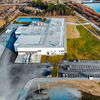Processing Your Payment
Please do not leave this page until complete. This can take a few moments.
- News
-
Editions
View Digital Editions
Biweekly Issues
- December 15, 2025
- December 1, 2025
- Nov. 17, 2025
- November 03, 2025
- October 20, 2025
- October 6, 2025
- + More
Special Editions
- Lists
- Viewpoints
-
Our Events
Event Info
Award Honorees
- Calendar
- Biz Marketplace
Pulling a 180 | Kennebunkport skate park designer Tom Noble quit the biz a few years ago. Now, he's back, and he's bringing company.
Since then Noble, now 42, along with his wife Sandy, have designed and built hundreds of custom skate parks across the country, including as many as 20 in Maine, bringing the nuances only a fellow skater can to halfpipes, vert ramps and trick boxes. He built his current facility in 2003 behind his home in Kennebunkport.
Saying Noble is passionate about skateboarding may be an understatement. "I haven't been able to find the right word, but passion doesn't even come close," he says on a recent morning in his office, wearing shorts and a t-shirt with his feet kicked up on the desk in front of him. "I will never be able to get the stink of skate off me and that's a good thing."
But a few years ago, his attachment to the skateboard industry underwent a rigorous test. After years designing and constructing custom skate parks, Noble abruptly quit the business at the end of 2006 after competition got too fierce as deep-pocketed playground companies, attracted by skateboarding's emergence as a mainstream activity, flooded the market.
Noble's hiatus from the industry didn't last long, however. During his self-imposed exile he kept close tabs on the industry and soon saw signs that these wannabe skate park designers had lost their grip on the market.
Noble figured the time was right to rejoin the market and spent last winter devising a comeback. And this time, Noble is taking a different tack, teaming Who Skates? with two Maine-based companies ˆ Sebago Technics and PM Construction ˆ in a collaboration that he says will bring professionalism to the industry. "As silly as that sounds, that's really new to the industry of skate parks," Noble says. "Bringing outsiders in I think brings a new perspective to the industry that also brings with it a new way of doing business."
That collaboration, says Noble, will allow the team to capture a large share of national work. Best of all, he adds, the market offers lots of opportunities, with millions of dollars worth of projects being put out to bid by municipalities all around the United States.
Chief among Who Skates? challenges, however, will be convincing the industry that its team should be considered among the best in the business. Noble wants to have a seat at the table when the biggest projects are going out to bid. For example, the three-firm team recently was shortlisted on a $400,000 bid to build a skate park in Omaha, Neb., along with two of the largest design-build skate park companies in the world. Noble said the municipal officials told them that Sebago Technics had prepared the most responsive and thorough plan they had ever read. "So that's what we're bringing to the table," Noble says. "I think the barriers we face short-term will be knocked down very quickly."
Ramping up
When Noble entered the business in the late 1980s, private skate parks like the one he built in Old Orchard Beach, called RATZ Skatepark, and subsequent ones he operated in Biddeford and Kennebunk, were the norm. Municipal skate parks, built and operated by the town, were unheard of. These days, private skate parks have all but disappeared. (Noble closed his Kennebunk skate park in 2004.)
But that hasn't meant the extinction of skate parks: Indeed, there are more than 2,000 public skate parks in the country and 2,000 more in the planning stages, according to Heidi Lemmon, executive director of the Venice, Calif.-based Skate Park Association of the United States of America.
But the industry's growth brought change that Noble didn't welcome. As skate parks in the early 2000s became big business, big business began building skate parks. In particular, playground companies such as Playworld Systems Inc., based in Lewisburg, Pa., and Delano, Minn.-based Landscape Structures Inc., entered the fray, building pre-fab ramps and rails that towns snapped up.
Noble says the playground companies came in with "a show of force and took over." Not only did these companies have million-dollar marketing budgets that dwarfed independent builders like Noble, but in many cases they also had existing relationships with the towns that bought their playground equipment. And, according to Noble, the products they sold were subpar and, well, not that cool. "They were designed by people who had never skated," Noble says.
The interlocutors weren't viewed kindly by the people involved in the skate board industry. "Quite frankly, if they were doing good work it would be one thing, but nine times out of 10 if we get a complaint about a park, it is a playground park," Lemmon says.
Some skate parks built by playground companies included design flaws that ruined the rideability of the parks or even caused injuries, Lemmon says.
But municipalities often thought more about their budget then of the quality of the ramps they were building for parks. The competition was a tough pill to swallow for Noble. "In any other industry you watch this chain of events occur and it gets frustrating," he says. "You don't know what you got 'til it's gone."
Noble's disillusionment led to a self-imposed exile from the business in 2006. It was short lived, and after a year he realized he missed the work and the people in the industry. He also was tempted back by what he says were promising signs the playground companies had lost their stranglehold on the business. Particularly, he read in online forums and news reports that skateboarders and municipalities were unhappy with what these playground companies were delivering. "More people like me got pissed off, picked themselves up and walked back into the bar to see who had kicked them out," Noble says.
Getting back into the business as an individual builder wouldn't have worked, though. So, with a winter spent thinking about new ways to tackle the industry, Noble devised a plan that he says will allow him to go after national work on a larger scale then he ever could on his own.
In early 2008, Noble convinced Sebago Technics, which has offices in Westbrook and Auburn, and PM Construction in Saco, to collaborate on skateboard park projects. (While Noble has always focused on skateboard parks, he says he and his wife have always had "a few pokers in the fire," and have worked with Sebago Technics and PM on some residential developments in the past. "They were invited to the table for a reason," he says.)
Previously, Noble often worked as a consultant or was contracted to only design the park and build the obstacles. But the new collaboration will allow the three-member team to tackle a project from beginning to end. This set up, says Noble, makes it easier for a municipality, which only has to work with one team, and makes it a more efficient project. "It's about control," he says.
Team skate
The collaboration is set up with Noble as the ideas guy who will work with the municipality and design a skate park that only another skateboarder could design. Sebago Technics brings the structural knowledge to the design table, and ensures everything meets codes. Once that design phase is complete, PM is the general contractor, budgeting the project, promising a price to the municipality and delivering the finished product on time.
Because these jobs could be all over the country, PM intends to work with subcontractors in the local communities. For instance, on a $400,000 project the team is bidding on in Omaha, Neb., PM would send out just two employees to oversee work that would take about six weeks to complete. And because most skate park companies send teams of builders to a job site, the Who Skates? collaboration could actually save money in the long run, says Noble.
The money municipalities spend on skate parks vary, from $50,000 or less for a small-scale park to millions of dollars for a big-city park. Noble says Who Skates? will chase after bids throughout that range.
While skateboard parks have grown up, building one still is a small project compared to the multi-million dollar buildings PM Construction is used to erecting, says Phil Morin, president and CEO of PM Construction, which focuses on retail and office space. Morin says that was his initial thought, but after a bit of poking around he recognized that this relatively young market could potentially offer a better profit margin than that of a traditional construction job. For starters, when bidding on a skateboard park, there'd be less competition, Morin says, than bidding on a commercial construction job in Maine. "The law of averages says you'll win a bit more and do better," he says.
And these days, there's plenty of work. Municipalities are embracing skate parks like they never have before. Today, Las Vegas has 22 skate parks, Lemmon says, and now requires new residential developments to include a skate park along with the typical basketball and tennis courts. Today, there are more than 2,000 public skate parks, she says, along with another 2,000 in the planning stages. Lemmon estimates that close to $100 million is spent a year on building municipal skate parks.
And municipalities are beginning to realize the benefit of well-done skate parks and not the "plunkers" the playground companies sell, Noble says. Even during the tough economic times, cities and towns are spending money for quality skateboard parks, he says. "I'm flabbergasted by the amount of work out there."
The design-build team is still young and hasn't yet built a skateboard park together, but it's working on several potential projects and has put in one official bid on the job in Omaha. Noble thinks the team could in various arrangements work on as many as 20 projects over the year and build as much as $2 million worth of skateboard parks this year. That appeals to his partners: Skateboard parks are a "new sector of business that we see as pretty promising in the future," Morin says.
Noble and the team would still be considered small fries compared to some of the larger skate park builders, such as Team Pain Enterprises in Winter Springs, Fla., but Noble says that's the way he likes it. He won't disclose what his profits are, but says only that with the low overhead ˆ he says 70% of his current business is design and consulting work on skate park construction ˆ he and his wife "extract enough profit from what we do."
But these days, Noble says he is maxed out and is even looking for a third partner to pick up some of the work fabricating skate park obstacles. If the new collaboration with Sebago Technics and PM Construction receives half the work the companies have bid on so far, Noble says he'll have to start turning away work. "If history serves, I'm about to be awarded twice as much work as we can conceivably finish," he says.
Mainebiz web partners

The Giving Guide
The Giving Guide helps nonprofits have the opportunity to showcase and differentiate their organizations so that businesses better understand how they can contribute to a nonprofit’s mission and work.
Learn More
Work for ME
Work for ME is a workforce development tool to help Maine’s employers target Maine’s emerging workforce. Work for ME highlights each industry, its impact on Maine’s economy, the jobs available to entry-level workers, the training and education needed to get a career started.
Learn More
Groundbreaking Maine
Whether you’re a developer, financer, architect, or industry enthusiast, Groundbreaking Maine is crafted to be your go-to source for valuable insights in Maine’s real estate and construction community.
Learn more-
The Giving Guide
The Giving Guide helps nonprofits have the opportunity to showcase and differentiate their organizations so that businesses better understand how they can contribute to a nonprofit’s mission and work.
-
Work for ME
Work for ME is a workforce development tool to help Maine’s employers target Maine’s emerging workforce. Work for ME highlights each industry, its impact on Maine’s economy, the jobs available to entry-level workers, the training and education needed to get a career started.
-
Groundbreaking Maine
Whether you’re a developer, financer, architect, or industry enthusiast, Groundbreaking Maine is crafted to be your go-to source for valuable insights in Maine’s real estate and construction community.
ABOUT
NEW ENGLAND BUSINESS MEDIA SITES
No articles left
Get access now
In order to use this feature, we need some information from you. You can also login or register for a free account.
By clicking submit you are agreeing to our cookie usage and Privacy Policy
Already have an account? Login
Already have an account? Login
Want to create an account? Register
Get access now
In order to use this feature, we need some information from you. You can also login or register for a free account.
By clicking submit you are agreeing to our cookie usage and Privacy Policy
Already have an account? Login
Already have an account? Login
Want to create an account? Register







Comments